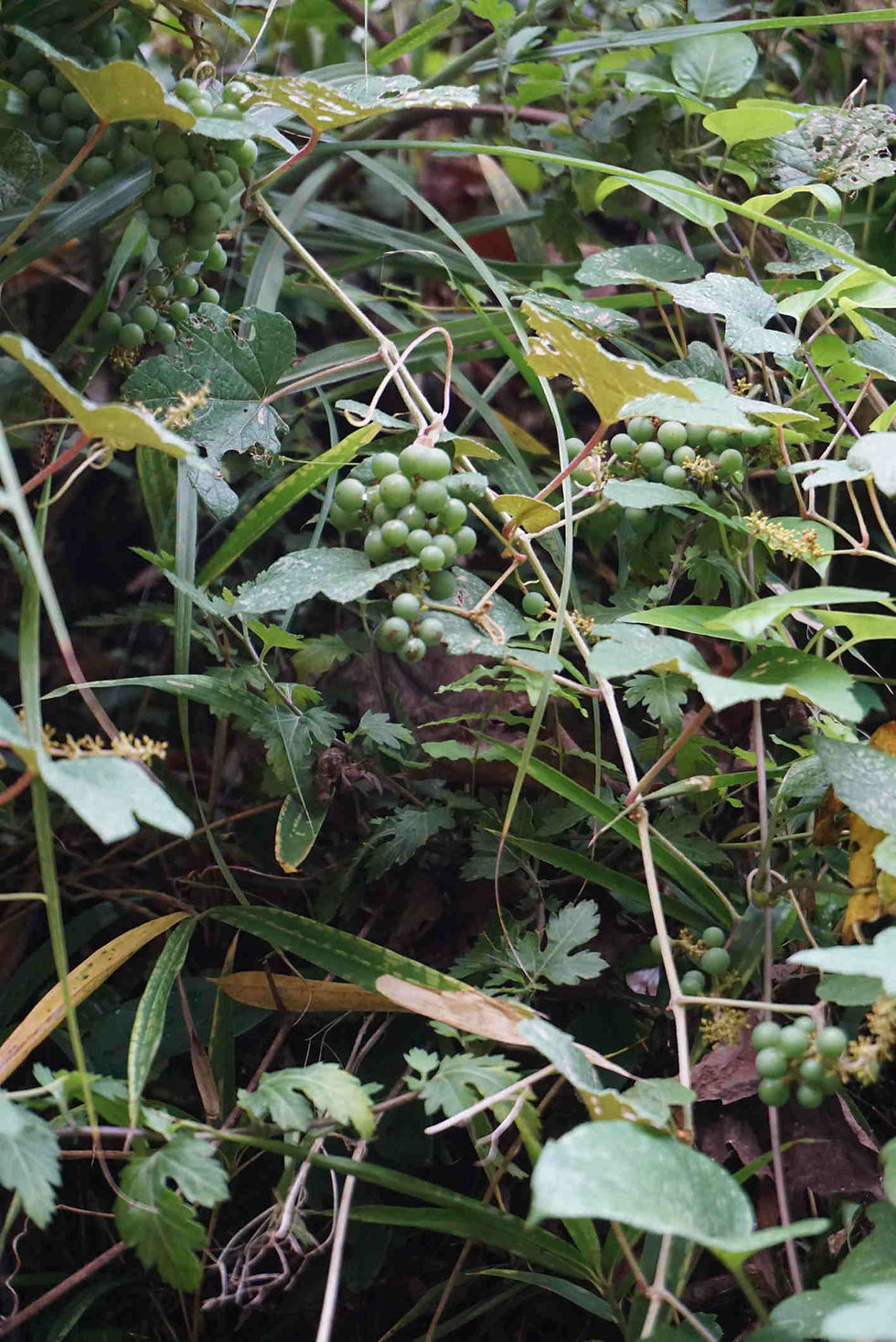愛宕の森と緑を守る会
Atago Mountain Plants-Trees 1
(Click the image to enlarge it and see the full description)
Trees and other pages (flowers are on pages 1 to 3 according to the season). Images of trees with flowers and fruits are also displayed by season. The species names are listed in order of Aiueo on the left side. Click to move to the location where the image was displayed.



赤芽槲、あるいは赤芽柏。トウダイグサ科アカメガシワ属の落葉高木。雌雄異株。空き地などにまず生える、典型的なパイオニア植物。愛宕山には広く分布している。


新芽は鮮紅色で、名前の由来が良く判ります。

良く見ると、葉の基部に、左右一対の丸い出っ張りがある。これは蜜腺体と言い、蜜を出す。一説にはアリを誘引し、他の害虫を排除させる働きをするという。



実は熟すと3つに裂け、3つの黒い種子が現れる。

馬酔木。ツツジ科アセビ属の常緑低木。別名、あしび、あせぼ。有毒で、葉を煎じて殺虫剤に用いる。馬が葉を食べると、酔ったようになるということで、この名が付いた。通常、草食哺乳類は食べるの�を避ける。

銀杏、公孫樹、鴨脚樹。イチョウ科イチョウ属で中国原産の裸子植物。葉は幅があるが針葉樹。イチョウ属は古生代末期を起源に中生代に広く繁栄し、その中の1種、イチョウだけが生き残った生きた化石で、絶滅危惧IB類に指定されている。 愛宕山にはイチョウは数少な�い。これは音次郎稲荷神社境内の樹齢250年を超える雄株。保存樹。

屋根を貫いているので、たまに屋根を広げているとのこと。 この樹を抱くと「"気"を貰える」との言い伝えがある、隠れたパワースポット?

観音密寺本堂の脇に生えている雄株。1987年(昭和62年)に本堂が火災で消失したが、イチョウは生き残り、その際の焼け跡が残っている。

イチョウの巨木に垂れ下がっている乳根(ちちね)で、長らく気根と考えられてきたが、根にも枝にも変化することがあり、古代の植物の特性であった担根体の名残ではないかとの説が唱えられている。しばしば安産・子育ての信仰対象に。写真は観音密寺の雄株。

鷲尾愛宕神社の門の脇に生える雌株の写真。愛宕山にはイチョウの樹は4本しか生えていない。残りの1本は愛宕神社の境内に。

実は熟すと黄色に。異臭があるが、中の種はギンナンとして食される。










榎。ニレ科エノキ属の落葉高木。建築用材、家具材などに用いられる。一里塚に植えられた木。 画像は愛宕神社の直ぐ下の道路脇にある保存樹。

エノキはゴマダラチョウ幼虫の食樹。幼虫は根元の枯葉の下で冬を過ごし、春になると幹を登って、若葉を食する。その他にも、食樹とする虫が多い。

蘡薁。クロウメモドキ目ブドウ科ブドウ属。学名Vitis ficifolia var. lobata。エビカヅラ(古名)。雌雄異株。画像は花が咲き終わった雌株。

これは開花直前の画像。夏に開花するが、5枚の花弁は開花後直ぐに落ちてしまう。葉の裏には毛が生え、乾かしてモグサの代用となる。

観音密寺境内の崖に生えている雌株。実は10月半ばには黒く熟し、食べることが出来る(ノブドウは似ているが食べられない)。しかし味わう前に、直ぐに鳥の餌食に。

黄梅。モクセイ科ソケイ属の落葉低木。中国原産で江戸時代に日本へ。中国名が「迎春花」で、早春に黄色の花を咲かせる。枝が角ばっているのが特徴。名前は「梅」だが花弁の形や雄しべの数も異なり、香りが無いなど、ウメとは似ていない。英名は「ウインタージャスミン」。よく似たウンナンオウバイは常緑低木で花冠が二重。よひらの脇で見られる。

大冬苺。バラ科キイチゴ属の常緑小低木で地表を匍う。9~10月に白い花が咲く。フユイチゴに似るが、葉柄に毛が密集していることで、区別できる。

晩秋になるとオオフユイチゴの赤い実が目立つ。熟した実は美味しい。
An evergreen tree of the genus Magnolia compressa in the Magnolia family. Also known as Magnolia compressa, the tree height reaches 25m. Also referred to as "Ogatama no Ki" or "Invitation Tree", it is the only evergreen tree in the Magnolia family and is a food tree for the larvae of the common jay. At the beginning of spring, the base is dark red and has fragrant white flowers. It is native to Japan and is distributed west of central and southern Kanto. Taiwan Magnolia compressa is distributed in Taiwan, south of Yaeyama. Many of the cultivated species in garden stores are different species, Magnolia figo native to China.
In Shinto ritual, the branch of Sakaki is generally used, but in fact, the branch of Magnolia compressa is originally used, and Sakaki is a substitute for it. It seems that it was difficult to obtain Magnolia compressa.
It grows in front of the stairs from the entrance of Atago Shrine (in the middle of the stairs).
The image of the common jay is from "Butterfly Picture Book" (www.j-nature.jp/butterfly/).

モクレン科オガタマノキ属の常緑高木。トキワコブシとも言う。樹高は25mに達する。「小賀玉の木」あるいは「招霊木」とも表記され、モクレン科では唯一の常緑樹で、ミカドアゲハの食樹。春の初めに基部がえんじ色で芳香のある白い花をつける。日本原産で関東中南部以西に分布。八重山以南、台湾にはタイワンオガタマが分布する。栽培種の多くは中国原産のカラタネオガタマ。

オガタマノキの花は早春に咲く。寒い風に吹かれて茶色のつぼみが開花を待つ。

まだ寒い早春に花が開く(2/14撮影)。モクレンやコブシより小さく、3〜4cmほど。白色〜クリーム色で、花弁の付け根付近は小豆色。良い香りがする花であるが、高い所に咲いているので今のところ確認できない。

10月にはすでに実が色づいている。神事には一般にサカキの枝が用いられるが、じつは、オガタマノキの枝を用いるのが本来であって、サカキはその代用。オガタマノキの入手が難しいからではないかと思われる。

落下している実の殻は開いてはいるが、かなり硬い。

オガタマノキはミカドアゲハ幼虫の食樹。この画像はトベラにとまり、蜜を吸うミカドアゲハ。「蝶の図鑑」(www.j-nature.jp/butterfly/)より。

自然に生えているのは珍しい。鳥によって種子が運ばれたのだろうか。
Other trees / plants -1

大崖石榴。クワ科イチジク属。東アジア南部に分布する常緑つる性木本。雌雄異株。茎から気根を出し、岩や木に付着する。

径4~5cm程度。果実の色は、最初は黄緑色で熟すにつれて紫色になっていく。葉は5~10cmの大きさ。


実(花囊)は雌雄とも同じ形をしている。

花はイチジクと同じように、花囊の中にあって外からは見えない。先端の穴に近いところの白いのが雄花。奥にあるエンジ色の小さな粒の一つ一つが�雌花。

受粉すると雌花が大きくなる。受粉は他のイチジク類と同じように、イチジクコバチによってなされる。

オオイタビの幼苗。岩を這っている姿と、立ち上がって樹に伝っている姿とがあまりにも異なるので、別種かと思ってしまう。

オオイタビの幼苗の葉。葉の大きさはせいぜい1cmで、ハート形に近い形をしている。

オオイタビの幼苗に良く似たヒメイタビ。国東半島で採集。(次の画像ともK氏提供)

ヒメイタビの幼苗には切れ込み(欠刻)のある葉が混じる。また、茎には毛が密集している。これらがオオイタビとの違い。(前の画像ともK氏提供)
Great cliff pomegranate. Urticales Morus alba, Ficus genus. An evergreen climbing tree that is distributed in southern East Asia. Dioecious. The leaves are extremely small between the young trees that stalk the rocks, and they resemble Himeitabi, but they can be distinguished by the steep angle of the leaves to the middle vein. When it stands up and travels to the tree, the leaves grow larger and resemble the Itabikazura, but the leaves of the Itabikazura are thinner and pointed. The flowers are from May to July, but like figs, they are attached to the inside of the flower sac (inflorescence) and cannot be seen directly. The flower sac is isomorphic, and turns purple when ripe in autumn. Pollination is done by fig bees, like other figs. The hole at the tip of the fruit is the doorway of the bee, the white one near it is the male flower, and the small enji-colored stubby in the back is the female flower. The female flowers of the female strain grow larger when pollinated, and when ripe, they become jelly-like and can be eaten.
Magnolia compressa

















































